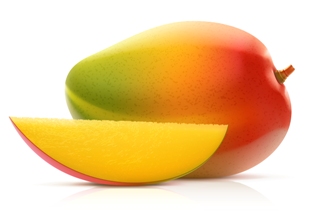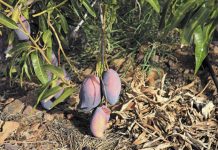 Mangoes belong to the genus Mangifera, consisting of numerous species of tropical fruiting trees in the flowering plant family Anacardiaceae. The mango is indigenous to the Indian Subcontinent. Cultivated in many tropical regions and distributed widely in the world, mango is one of the most extensively exploited fruits for food, juice, flavor, fragrance and color, making it a common ingredient in new functional foods often called superfruits. Its leaves are ritually used as floral decorations at weddings and religious ceremonies.
Mangoes belong to the genus Mangifera, consisting of numerous species of tropical fruiting trees in the flowering plant family Anacardiaceae. The mango is indigenous to the Indian Subcontinent. Cultivated in many tropical regions and distributed widely in the world, mango is one of the most extensively exploited fruits for food, juice, flavor, fragrance and color, making it a common ingredient in new functional foods often called superfruits. Its leaves are ritually used as floral decorations at weddings and religious ceremonies.
Prospects and Strengths
* Mango growing is in line with the initiatives of both government and private sectors in terms of production, processing and marketing support
* Once productive, a 10-15 year old tree will yield approximately 500 kilos
* There is a niche market for both fresh and processed mangoes locally and abroad. The export market is expanding
* Technologies from propagation to post-harvest handling have been tested, verified and adopted nationwide
* Processing technologies are also available and continuing efforts are exerted to develop new products
* There is a pool of experts in the country that can be tapped to provide technical assistance to mango growers and processors
* Research and development activities on emerging pests and diseases are given priority by relevant agencies of the government
* Expansion of large production areas in Mindanao which are free from typhoons
Favorable Growing Conditions
* Elevation: within 600 meters above sea level (400 m considered ideal)
* Temperature: 21°C-27°C
* Weather for inducing maturity of vegetative parts and flowering: distinct wet and dry (3 to 5 months-dry)
* Weather for fruit development: plenty of sunlight
* Ideal soil: loamy, relatively high in organic matter
* Soil pH: 6.0 to 7.0
* Soil texture: good water holding capacity
* Topography: flat to rolling, not exceeding 45 degrees gradient
* Drainage: well-drained soil; less moisture level needed during maturation of leaves and buds, flowering, fruit set and ripening
* Distance of planting: depending on variety
The following varieties have been found promising and are recommended for production.
• Alphonso
• Zill
• Julie
• Palmer
• Keitt
• Lippens
• Saigon
• Edward
• Haden
• Early gold
They mature 3– 4 years after transplanting or in-situ grafting. These varieties are available
Propagation
Mangoes are propagated using grafts raised though veneer grafting or any other propagation technique. These techniques are:

VENNER GRAFTING
In this technique scion selection is of utmost importance. Terminal shoots of about 3 months are prepared by defoliation 10 days prior to severance of such shoots from the parent trees. At this stage, all the petiole stubs drop and buds begin to buldge. Such scions are ready for grafting or may be stored for about a week by wrapping them in wet newspaper and packed in a polythylene bag.
Rootstocks for grafting are obtained from stones (seeds) sown in the pre-nursery spaced 50 cm apart or obtained from seeds sown directly in a 30 x 50 cm polybag containing manured topsoil. Grafting is done when the seedlings are about pencil size. 5 cm long slanting cut is made at the proximal end of the scion stick. A similar cut is given on the rootstock so that both fit well without any air space in between. After joining the two, they are tied lightly with polythylene tape. About three weeks after grafting when the scion begins to sprout, the upper part of the rootstock is clipped off. After about 1,1/2 months, when the scion has grown sufficiently the stock is cut back just above the point of union. Thereafter the mango grafts are ready for transplanting and this should be done within one week. It is essential that the grafts always be kept wet.
EPICOTYL GRAFTING
Sow seeds on sand or leaf mould so that it can be removed without disturbing the roots. Freshly germinated seedlings are taken out with all their roots and kept in a bucket of water. The seedlings are taken out one by one when they are about 10 to 30 days old, and bench grafted by wedge method using thinner scions. The scions are prepared by defoliation 10 days prior to grafting. The scion and stock are then tied together lightly with polythylene tape. The graft is immediately planted in a polythylene bag filled with a potting mixture.
Newly planted grafts are watered and kept either in the glasshouse or under a covered shed but never in the rain, till sprouting.
Sprouting begins after about 21 days. Grafts prepared by this technique though smaller in size, can better withstand transportation. Survival of the plants is also much higher than plants prepared by other techniques.
Grafting method
STOOLING
This technique may be useful for the clonal propagation of mango rootstocks. The plants are headed back (cut) after about 2 years of growth to height of 20 cm during February. Indole Butyric Acid 5000 ppm in lanolin is applied in the ring of the shoots developed after heading back during July. Percentage survival of plants is about 80%.
TOP-WORKING OF INFERIOR SEEDLINGS
This technique is used mostly for inferior trees found growing as isolated plants. Such inferior trees in the age of 10 –20 years can be converted to superior varieties by top-working, and such trees start bearing again after 3 years. The seedling trees are headed back to a height from where branching begins.
The cut ends are treated with fungicidal paint. New shoots will develop below the cut ends. When these shoots are about pencil thick they are veneer grafted as detailed earlier. The grafts here develop much faster than nursery plants. Within 3 years, the tree will have half the size of the original canopy. Under home garden, several cultivates of identical growth habit can be grafted on the one tree.
Orchard
After about 11/2 months, the grafts are removed from the nursery bed with a ball of earth. If the graft is too big, branches are pruned to reduce leaf area. In extreme cases, remove all leaves before transplanting.
However, for quick establishment of mango orchards, grafting seedling in-situ is highly recommended. Here, mango stones are planted out in the field after lining. Seedlings may be used. Established seedlings are then venner grafted (as discussed earlier) in-situ. Seedling are planted at distances of 10 m x 10 m apart each way for dwarf cultivars. Dig holes 50 cm x 50 cm. The pits may be filled with one bucket of compost duly mixed with soil. The grafts are planted one in each planting. Watering may be continued during dry season, plant may be mulched to retain moisture.
Fertilizer
After fertilizer in ring to each plant. The fertilizer should be in the following proportions,
• 1st year: 100 g N.P.K (1:1:1) per plant – one dose.
• 2nd year: 200 g– N.P.K (1:1:1) per plant– three doses
STOOLING
This technique may be useful for the clonal propagation of mango rootstocks. The plants are headed back (cut) after about 2 years of growth to height of 20 cm during February. Indole Butyric Acid 5000 ppm in lanolin is applied in the ring of the shoots developed after heading back during July. Percentage survival of plants is about 80%.
Pests
In Nigeria, pests are not a serious problem at present in mango orchards, however incidence of some pests may occur .Coccus spp. which attacks the fruits and the leaves. Control by applying Rogor 40 EC at 15 mls per 10 liters of water.



